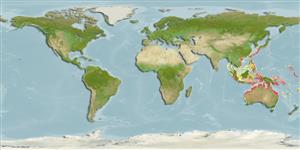Environment: milieu / climate zone / depth range / distribution range
Ecology
Marine; reef-associated. Tropical
Western Pacific: northwestern Australia and elsewhere in the region but mainly southwest Pacific.
Size / Weight / Age
Maturity: Lm ? range ? - ? cm
Max length : 39.0 cm TL male/unsexed; (Ref. 9710)
Inhabits shallow inshore waters and offshore soft bottoms (Ref. 9710). Feeds on fishes and invertebrates (Ref. 9710). Highly toxic and is responsible for amputation of swimmers toes (Ref. 9710).
Life cycle and mating behavior
Maturity | Reproduction | Spawning | Eggs | Fecundity | Larvae
Kailola, P.J., 1991. The fishes of Papua New Guinea: a revised and annotated checklist. Vol. III. Gobiidae to Molidae. Research Bulletin No. 41, Research Section, Dept. of Fisheries and Marine Resources, Papua New Guinea. 153 p. (Ref. 6771)
IUCN Red List Status (Ref. 130435: Version 2024-2)
Threat to humans
Venomous
Human uses
Tools
Special reports
Download XML
Internet sources
Estimates based on models
Preferred temperature (Ref.
123201): 24.6 - 29.3, mean 28.4 °C (based on 1929 cells).
Phylogenetic diversity index (Ref.
82804): PD
50 = 1.0000 [Uniqueness, from 0.5 = low to 2.0 = high].
Bayesian length-weight: a=0.02570 (0.01199 - 0.05511), b=2.89 (2.71 - 3.07), in cm total length, based on LWR estimates for this (Sub)family-body shape (Ref.
93245).
Trophic level (Ref.
69278): 4.0 ±0.62 se; based on food items.
Resilience (Ref.
120179): High, minimum population doubling time less than 15 months (Preliminary K or Fecundity.).
Fishing Vulnerability (Ref.
59153): Low to moderate vulnerability (29 of 100).
Nutrients (Ref.
124155): Calcium = 37.2 [15.5, 104.8] mg/100g; Iron = 0.569 [0.285, 1.299] mg/100g; Protein = 18.6 [16.4, 20.8] %; Omega3 = 0.127 [0.065, 0.242] g/100g; Selenium = 39.6 [19.6, 85.8] μg/100g; VitaminA = 49.4 [13.8, 182.8] μg/100g; Zinc = 0.852 [0.567, 1.292] mg/100g (wet weight);
